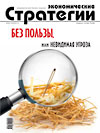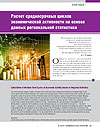Calculation of Medium-Term Cycles of Economic Activity Based on Regional Statistics
The article presents analysis results of medium-term economic cycles, calculated on the basis of statistical data of one of the regions of the Russian Federation. For analysis, the average cycles of Simon Kuznets (construction cycles), the small investment cycles of economic activity of Clement Juglar and short business cycles of Joseph Kitchin are taken. Bringing together the graphs of three cycles shows the convergence at the bottom point of three medium-term economic cycles in the period of 2019–2020. A conclusion is made about the need for investment growth in 2018. Also a graph is given with a large cycle of capital accumulation by Giovanni Arrighi, characterizing the cyclical change in the model of world development in connection with transition to a new dominant resource, as a result of which the country — the world leader — changes. Thus, according to J. Arrighi, the American cycle should be replaced by the Asian one, which is why 2018 is designated as the year of beginning of the active phase of the US struggle to maintain its domination. According to the authors, realization of J. Arrighi’s cycle took place meanwhile the center of the world’s money emission was moving following the center of world commodity production. It is concluded that the considered cyclicity will be the background for pursuing the economic policy in the regions of Russia, but will not determine it.
References:
- Komparativnye issledovaniya ekonomicheskoi istorii (Istoriya mirovoi ekonomiki, vyp. I): sbornik statei [Comparative studies of economic history (History of the World Economy, Edition I)]. Istina, 2012, available at: https://istina.msu.ru/media/publications/article/705/752/3623888/Wallerstein_and_Arrighi_History_of_World_Economy_1.pdf.
- Grinin L.E., Korotaev A.V. Vzaimosvyaz’ dlinnykh i srednesrochnykh tsiklov (kondrat’evskikh voln i zhyuglyarovskikh tsiklov) [Interrelation of Long and Medium-Term cycles (Kondratiev Waves and Juglar Cycles)], available at: ttps://www.socionauki.ru/book/files/k_waves/volume_3/015-073.pdf.
- Konotopov M.V., Tebekin A.V. O mirovom ekonomicheskom krizise s pozitsiy biznes-tsiklov ekonomicheskoy aktivnosti Dzh. Kitchina [On the World Economic Crisis from the Perspective of Business Cycles in Economic Activity by J. Kitchin]. Innovatsii i investitsii, 2010, no 3, pp. 2–4.
- Ekonomist Sergei Khestanov: «Yagodki eshche vperedi, no vesnu ya vam garantiruyu!» [Economist Sergei Hestanov: “Berries are Still Ahead, but I Guarantee You Spring!”]. Komsomol’skaya pravda — Perm’, available at: https://www.perm.kp.ru/daily/26323.7/3203616/?cp=2.
- Sistemnye tsikly nakopleniya. Sotsiologicheskaya kontseptsiya Dzhovanni Arrigi [Systemic Cycles of Accumulation. Sociological Concept of Giovanni Arrighi]. Studexpo, available at: https://studexpo.ru/6288/sotsiologiya/sistemnye_tsikly_nakopleniya.
- Arigi Dzh. Dolgiy dvadtsatyy vek: den’gi, vlast’ i istoki nashego vremeni [Long Twentieth Century: Money, Power and the Origins of Our Time]. Moscow, Territoriya budushchego, 2006.
- Protasov A.Yu. Sistemnye tsikly nakopleniya Dzh. Arrigi i dlinnye volny inflyatsii: Nauch. stat’ya po spetsial’nosti “ekonomika i ekonomicheskie nauki” [Arrighi’s Systemic Cycles of Accumulation and Long Waves of Inflation]. SyberLeninka, available at: https://cyberleninka.ru/article/n/sistemnye-tsiklynakopleniya-dzh-arrigi-i-dlinnye-volny-inflyatsii



